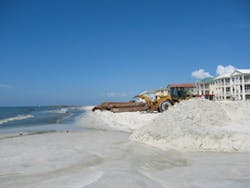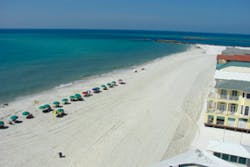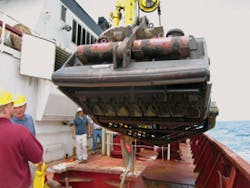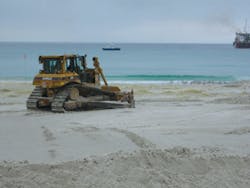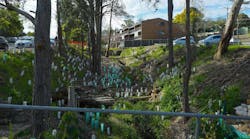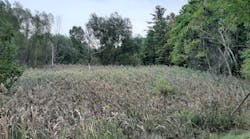When Jim Trifilio is asked to share the story of Okaloosa County’s effort to restore two pristine beaches along Florida’s northern Gulf Coast, he pauses and takes a short breath.
“How much time do you have?” he asks with an uneasy laugh. “It’s a long and harrowing story. I’m not even sure where to start.”
Trifilio, who was hired in December 2005 as the first coastal management coordinator for the Okaloosa County Tourist Development Council (TDC) to begin the Okaloosa Island Beach restoration project, knows exactly where the story starts.
“You need three things to restore a beach: You need sand. You need money. And you need permits,” explains Trifilio, who along the way had the Western Destin Beach project added to his responsibilities.
Okaloosa County would need a lot of all three for the Western Destin Beach and Okaloosa Island Beach projects. “Okaloosa Island”-the local term for a smaller segment of Santa Rosa Island-is home to hotels, motels, condominiums, and other beachfront properties.
The Western Destin project, as described in a state permit approved December 16, 2011, would involve the “placement of approximately 831,000 cubic yards [cy] of beach quality sand along a 1.7-mile segment of Okaloosa County immediately east of Destin’s East Pass. The project provides an average beach fill volume of 92 cubic yards per foot. The project design includes a 30-foot-wide dune crest at +14 feet NAVD, with a transitional slope of 1V:4H from the dune crest to the back-berm, a 30-foot-wide back-berm at +8.5 feet NAVD, with a transitional slope of 1V:10H from the back-berm to the berm and a variable-width berm at +5.5 feet NAVD, with a transitional slope of 1V:10H from the seaward edge of the berm out to the existing sea bottom.” Since that time, a permit modification removed a 2,900-foot stretch from the middle of the project.
The Okaloosa Island project, outlined in a February 6, 2012, state permit, “includes the placement of approximately 940,000 cubic yards of beach-quality sand along a 2.8-mile segment of Santa Rosa Island. The design includes a 40-foot-wide dune crest at an elevation of 14 NAVD, a 60-foot-wide back-berm of 8.5 fee NAVD, and a variable width berm at 5.5 feet NAVD. The dune will transition into the back-berm at a 1:4 (vertical: horizontal) slope; the back-berm will transition into the berm at a 1:10 slope; and the berm will transition into the existing sea bottom at a 1:10 slope. In areas where the landward edge of the dune crest does not tie into the existing dune, the landward dune will merge into the existing topography at a 1:4 slope.”
They may not have been particularly large or challenging restorations from an engineering standpoint, but these were no ordinary dredge-and-fill projects. Northwest Florida’s beaches are composed of some of the whitest, softest sand in the world-and locals are extremely protective of them.
“Mother Nature Needs Help”
The beaches that dazzle the eye were formed from quartz crystals created over millennia as the Appalachian mountains weathered, rivers carried the particles to the Gulf of Mexico, and waves deposited those crystals along miles of shore (Source: “Battle of the Beach Sands,” by David McRee, http://www.visitflorida.com, June 15, 2009). “You just don’t see this type of sand anywhere,” insists Sarah “Sam” Seevers, mayor of Destin.
Seevers notes that beaches were renourished in the wake of 1995’s Hurricane Opal. The vicious Category 4 storm “absolutely devastated them”-ripping away 100 feet of beachfront-and restoration work is required from time to time to maintain them. “Mother Nature needs help. She cannot refurbish those beaches naturally. And it’s critical that we help her out now and create more beaches.” Since Opal, the only restoration projects in Okaloosa County were a project of roughly 2 miles in length in eastern Destin, completed in 2007, and a small emergency project in western Destin in 2010.
Seevers is also a strong advocate of restoration projects because the local beaches are the area’s top economic driver. “Our beaches contribute a little over $200 million a year to our economy. Okaloosa County is 940 square miles; Destin is 25 square miles. Our population of 12,305 swells by 65,000 to 75,000 on any given day in season and we contribute 39% of the total economic impact to the whole county,” she states.
Where the story of the restoration projects begins for Trifilio is with the second ingredient-money-because, as he notes, “You obviously can’t do anything without funding.”
Okaloosa County already had some restoration funding in place when Trifilio was hired, thanks to a noncompetitive grant from the state. “It could only be used for Okaloosa Island, but it wasn’t going to be enough,” he recalls.
The TDC, which was already receiving a portion of the local 4% tax on short-term rentals, hotels, and motels, successfully advocated for an increase to 5%. The entire increase-as much as $2.2 million in a good tourist season-was dedicated to beach rejuvenation. The county hired a consultant to develop a comprehensive funding strategy.
Enter the MBSU
Workers in Destin, FL, in May 2007
Florida governmental entities have the authority to form municipal benefit service units (MBSUs) to fund certain public projects. An MBSU is defined as a “special assessment district established for funding an essential public service and/or improvement that benefits the property included in the assessed boundary of the district. Assessment (property cost share) is allocated on a unit of measure that equitably represents benefit. MBSU assessment is not determined according to property value.”
Trifilio describes the MBSU as “the third leg of the stool” to fund the projects. Property owners on the beach would be subject to two assessments-the first for the storm protection benefits they would receive and the second for recreational improvements. Property owners immediately off the beach would pay only the recreational assessment under the idea that a more appealing beach would make their rental properties more appealing and valuable, too.
The recreational assessment was set at about $50 per year for eight years. The storm protection assessment would be $150 to $200 a year, also for eight years. “MBSUs are one of those things you’re never going to get perfect. It’s like a fire assessment. If I live next door to the fire department and you live 2 miles away, should I pay less for the same protection?” Trifilio asks. “Residents in the north part of the county weren’t going to be happy paying to restore the beach for what they perceived to be “˜a bunch of rich people,’ so we came up with what we felt was a reasonable compromise.”
Approval of the MBSU was only one component to emerge from approximately 50 public hearings and workshops held from early 2006 through late 2011. Those hearings drew a small but vocal group of residents opposed to the MBSU and the beach renourishment work.
As the TDC won competitive grant funding topping $6 million and the county began to collect the additional bed-tax revenues, the citizens’ group mounted a legal challenge to Okaloosa County’s plan to bond for up to $20 million in project costs and service the debt with the various revenue streams. The suit went to the Florida Supreme Court. After several years, the county position prevailed.
On to the Sand
With the funding sources secured, a cooperative effort between the city, county, and Eglin Air Force Base turned its attention to locating the best sand source.
“Eglin owns miles of beachfront,” Trifilio observes. “It’s pretty much undeveloped, but they do have radar facilities right on the coast. One had been subject to a lot of erosion over the years, and they wanted to protect it.”
After testing a number of sites at a cost of $1 million, the three entities narrowed their choices to two borrow areas; one is about 7 miles offshore, and the other is “centered approximately 1.25 miles off Okaloosa Island and three miles west of East Pass, within a relic ebb tidal delta in water depths of -36 to -51 feet NAVD,” according to the state permit. Use of the latter borrow area was approved for up to five years.
Eglin Air Force Base, a local mainstay since its opening in 1937, launched its restoration and beachfront armoring project in late 2009. Its improvements to Santa Rosa Island in 2010 cost more than $112 million in a move to “eliminate or minimize damage” from future hurricanes (Source: “Eglin CE Armors Island Against Hurricanes,” by Mike Spaits, Team Eglin Public Affairs, June 4, 2010). The three-phase project, involving several contractors through the US Army Corps of Engineers and under the guidance of the 96th Civil Engineer Group (CEG), began by repairing and armoring roads, building retaining walls, and restoring beaches. Sea walls were constructed in the second phase, and a larger-scale beach renourishment last year rounded out the work.
Dan Robeen, the 96th CEG’s chief of programs division, said in June 2010 that the project’s impact extended beyond the military base. “One of the additional benefits to this work is Destin will be able to use the dredge contractor to help beef up Holiday Isle when they’re finished with our work. Without a contractor being in place for Eglin, the cost to the city and county would have been exponentially greater,” he said. (Ibid.)
Opposition Mounts
Meanwhile, Trifilio and elected officials were dealing with a different sort of rising tide-a tide of growing public opposition. But Trifilio sensed it was manageable.
Noting he and the former president of the Okaloosa Island leaseholders’ formal advisory group disagreed about the MBSU, Trifilio adds, “We had a reasonable disagreement. She felt the county should pay for it all but wanted the project. My point was that you were never going to get the people in the north part of the county pay for “˜rich people down on the beach.’ I expect that kind of conversation and welcome that.”
What he didn’t anticipate was the intensity of two year-round island residents who took the lead in opposing the project. Their efforts included mobilizing beachfront property owners who lived in other states most of the year.
Destin, May 2007
Noting the Sunshine State’s penchant for transparency, Trifilio indicates the two residents used available public information to their advantage, including photos of core samples containing sand that never would have been used for the Okaloosa Island restoration project. “They were very, very good at what that did. They were constantly sending “˜the sky is falling’ e-mails and bombarding property owners who didn’t live here year-round with e-mails about how awful this project was,” Trifilio recalls. “They sent an e-mail around to everyone showing a sample with a layer of organic material and indicating that was the type of material we were going to put on the beaches. It was a core sample from a site we weren’t even going to use. That was the kind of thing they weren’t afraid to do.”
Trifilio emphasizes that several factors constantly drive him to ensure the two projects created the best possible results. “I have a motivated self interest: My salary comes from the bed tax, so I’m the last one in the world who wants to mess up the beaches. That’s where my salary comes from,” he insists.
Seevers is as adamant as Trifilio on that point: “Tourists do not drive here to not go to the beach. They come here for a specific reason-our 24 miles of gorgeous, sugar-white beaches. Our beaches are the heart and soul of the economy here in Destin, I wouldn’t do anything to endanger that.”
She adds, “I would never settle for anything less than quality sand. We have already done two projects. Both projects, when wet sand is put on the beach it looks darker, but if you go and walk on those beaches today, you will not see anything different. I don’t quite understand that argument [that inferior sand would be used].”
What’s more, Trifilio notes, the process of granting restoration permits is as exhaustive as it gets, beginning with a feasibility study by engineers to determine if restoration is needed. A Jacksonville firm, Taylor Engineering, conducted the studies for Destin and Okaloosa Island and concluded work was needed.
Before any work can take place, approval is required by a host of state and federal agencies, including the Florida Department of Environmental Protection, the US Army Corps of Engineers, the US Environmental Protection Agency, Florida Fish and Wildlife, Fish and Wildlife Coastal Resources, and the National Marine Fisheries. “It’s a very mature process. It often takes three or four years to get one of these permits, and you have a lot of people looking at it,” he adds. “It’s not like we went down to the local gas station and got ourselves a permit.”
Ultimately, after laboriously assembling all three members of the Holy Trinity of beach renourishment through six years of hard work by a number of local, state, and federal agencies, the Okaloosa Island beach restoration was stopped in its tracks. The Okaloosa County Board of Commissioners voted to put the brakes on the project.
In the end, Trifilio concedes, “We went through eight or nine litigations and we won every one of them. What we lost was the public perception battle.”
Different Beach, Different Challenge
Destin Beach property owners’ opposition wasn’t about taxation or sand quality; it was about property rights. A Florida beach restoration project using public money results in the creation of a public beach along that shoreline.
“They didn’t want a public beach in front of their private beach,” Trifilio says, explaining that the project and erosion control line fix the formerly fluid southernmost property boundaries.
The Destin Beach property owners had taken their fight all the way to the US Supreme Court in a case that began even before Trifilio arrived on the scene. It was prompted by an earlier plan to rejuvenate Eastern Destin Beach, in which a number of property owners refused to grant temporary construction easements for the work. The city of Destin moved forward nonetheless. Ultimately, the high court unanimously sided with the city.
“We basically had the tale of two cities. The [e-mailing opponents] were saying the sand quality was bad but there were no private property issues because the county owns the [island beachfront], while the people at Destin Beach were more concerned about their property rights.”
Seevers notes that she and the city’s council members are very conscious of private property rights whenever a restoration project is undertaken. “It is our duty to protect the upland structures and health, safety, and welfare of the public. That’s the top priority in our eyes,” she explains.
At the same time, she adds, “Each restoration is paramount to keeping a strong economy in our city and making sure the folks in our city can live their lives as they’re used to living them.”
While the Okaloosa beach project is at a standstill, rejuvenation of Destin Beach was put out to bid in September 2012. As of press time, the work was scheduled to begin in January 2013, with ownership of the Destin permits transferred to the city of Destin.
Trifilio is hopeful the Okaloosa Beach permit eventually can be put to use. It has a five-year life and could be renewed for another five years, which could be vital if a major hurricane rolls through the area during that time and wreaks havoc on the island beach. Ultimately, though, any work will rely on that second key ingredient-money. And, at some point, those hard-earned state grants will be returned long before the permits expire.
“It’s not a question of if we get hit, it’s a question of when. It’s smart to have those permits then, because we’ll want to restore that beach quickly. We have to have the money to restore the beach so we have tourists, and we have to have tourists to have money to restore beach, so it’s a real chicken-and-egg thing,” Trifilio says.
An out-of-court settlement was reached with the recalcitrant Destin Beach property owners, creating a 3,000-foot-plus gap in the 1.7-mile-long rejuvenation but clearing the way for work to proceed. “The sand will fill in that gap area and those people will basically get free sand and not have a public beach in front of them. It’s not the ideal way to do it, but it was a necessary compromise to get the project done,” Trifilio concedes.
Hurricane Isaac’s brush with the local coast, which didn’t pack much more than a tropical storm punch, provided foreshadowing of the damage to come if rejuvenation isn’t done. “Both the east and west ends need it, but especially the west. It’s going to be hard for those folks to rent out their condos as beachfront property if they don’t have a beach,” Trifilio predicts.
Turtles and Tourists
The Destin project was scheduled to begin in January, a time of the year when turtles and tourists are sparse. “Obviously, we don’t want to do it when tourists are here or during turtle nesting season, which runs from May to October,” Trifilio explains. “You can do it then, but you have to have turtle trawlers that go before the dredge and scoop up turtles so they don’t get sucked into the dredge.”
Taking a sea turtle is a violation that will shut down the dredging operation-at a cost of up to $100,000 a day-until federal wildlife officials give the all-clear to resume operations. Trifilio notes that on an earlier project, the city of Destin went over its turtle-taking quota and was forced to bargain with another region for its turtle credits. The resulting one-week idle time contributed significantly to the project’s $1.2 million cost overrun.
Although a January start date is outside the nesting season, Destin officials are not taking any chances this time and will have a trawler in place throughout the project. January also falls outside hurricane season.
The project is predicted to be a short one, with a month of actual construction book-ended by several weeks of equipment mobilizations and demobilization. A hopper dredge will drag cutter heads along the Gulf floor, and a vacuum will suck up and deposit sand in the dredge’s hold. The dredge will steam to a point near the beach and connect to a pipe that will pump the wet sand onto the beach, where bulldozers will shape it into a profile determined by engineers.
“We’ll be ready for the spring season. The sand is going to be darker at first because it’ll be wet. There will be some organic material in it, but over time it will dry out, the organic particles will be gone, and you’ll just be left with quartz sand,” Trifilio explains. “Within six months you’ll see a noticeable difference, and the positive impact lasts a lot longer. The East Coast can lose 3 or 4 feet of beach in a year, but our wave energy is much lower, so our erosion is very, very low.”
Those who complain that renourishment is a waste of money should look to a 2007 Destin project, where more than 90% of sand pumped onto the beach is still where it was intended to be, Trifilio notes. “Opal took away our double sand bars, but since we did that project the sand bars are back. That’s very important, because the waves break there and their energy dissipates so the dry beach doesn’t bear the brunt.”
Trifilio acknowledges feeling frustrated by the success of the small but vocal group. “It’s easy to take a picture and say, “˜Look how wide the beach is,’ but you’ve got to run the numbers. We received the state grant because there is an objective criterion that defines a critically eroded beach. The island beach is critically eroded and it needs restoration, according to the state. They’re the experts, and I’m going to defer to experts before I defer to someone out there with a Brownie camera,” he insists.
We Work for the People
Trifilio harbors hope that a successful Destin project will alleviate the concerns of Okaloosa Island property owners and prompt them to reconsider. “We’re going to do our absolute best on the Destin project and make it as perfect as possible. One objection is that there may be too many shells in the sand. We have a backup plan to remove them, but as far as the island is concerned, [that project] is going to depend on public outcry after a large hurricane,” he predicts. “I guarantee we’re going to lose that state money because the 2004-20005 money is old money. Losing $7 million is hard to swallow. It’s ultimately a political decision.”
Okaloosa County Commissioner Don Amunds says the Destin beach project is receiving the high-priority attention it deserves because erosion has taken its toll on jetties and several condominiums.
“If there’s no beach to lay out on, that’s not a condo you want to live in or rent. If you don’t want to go there, it loses its value, and eventually those properties will go into foreclosure. Before long, you’re stuck with buildings no one wants, and you can’t collect the bed tax on any of them, and without the bed tax you can’t restore the beaches,” he says. “So it really is a domino effect.”
Amunds, who was in the 4-1 majority in voting against the Okaloosa Island project, acknowledges that the project is not going forward any time soon-and he believes for good reason. “It’s dragged on for six years. Originally, there were a lot of people who said they wanted to do it and said we were going to restore the reefs just offshore, too. A lot of people got tired of hearing it and said, “˜Let’s leave it up to Mother Nature and what happens, happens.’ It didn’t get the support, for the most part, and both sides were using money in court over and over again. At some point, when people say, “˜Don’t fight any more,’ you have to say we’re not going to do it, because we work for the people,” he explains.
For now, Trifilio is pursuing federal shore protection designation for Okaloosa Island and Destin’s beaches. The result would be a cost-sharing arrangement in which the US government would cover half of any restoration project costs. Depending on available state dollars, the local match for any work could shrink to 25%.
“A feasibility study would be the next step, but with no budget earmarks from Congress any more, it’s difficult to get funding for that,” Trifilio says. “As an example of how patient you have to be, there’s a beach in east Florida that got the designation after 60 years because it was dormant for many years and had no local sponsor. I go to Washington every year. We have a federal lobbyist, and we’re working much harder to
get it.”
Update on the Work
As this issue of Erosion Control was going into production in mid-December 2012, Trifilio offered the following update: “The western Destin project is on target to begin January 2013. They’ll mobilize and probably begin work by middle of January, and the project shouldn’t take more than a month, with a week or two to demobilize. The low bidder is a company called Great Lakes Dredge and Dock. Their bid was around $6.8 million. With other costs we should still be a bit under the $8 million projected cost.
